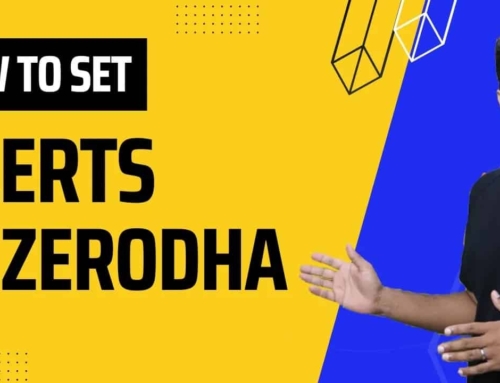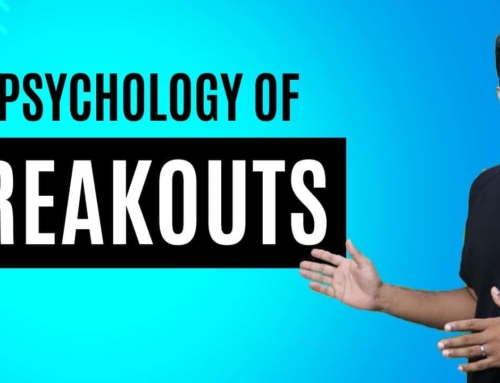How to Take High Probability Trades?
In the world of trading, this jargon gets thrown around a lot. It is called the High probability trades. Everybody wants to take a high probability trade, but very few people actually understand what it really means. So in this article/video, we will break down this concept and explain that using very simple examples.
A high probability trade basically means that the trade has a very high chance of working out, but who determines the probability? Is it you? Is it me? Is it somebody else? How can someone say that the trade has an 80% or 90% chance of working out?
There is a lot of subjectivity here. What you may call a high probability trade, I may look at the same setup and call it as a low probability trade. What we need here is an objective way of looking at this so that everyone looking at it would arrive at the same conclusion. So how do we solve this problem?
Well, think of any stock, like your old friend, a person that you have known for a long time. Since you know them so well, you can tell with a fair degree of confidence how that person would behave. You can say with conviction that this person usually is very reliable, cool-headed or even hot tempered.
You can also conclude that this person is usually on time or late. So, how can you know all that? That is because you know that person’s personality, their history and have spent a lot of time together over the years. In the same way every stock has its own personality and we can learn that by looking at the way they have behaved in the past.
Some stocks are volatile, whereas some stocks are very stable. Some are trending, whereas others are range-bound. Some stocks react a lot to earnings whereas some do not react at all. Hence a high probability trade is nothing but a trade taken based on the personality of the stock. Let us understand how it is done.
We first look at the historical performance of the stock and based on that, we calculate the standard deviation, which is a measure of how much movement the stock usually makes.Then we plot something called a Bell Curve and using this bell curve, we can deduce what most likely is to happen and what is very unlikely to happen?
For example, based on the history of Tata motors, we can say that this stock has been very volatile. It can easily come down or go up 10% and we would not be surprised. However, if we look at a stock like Reliance or ITC and if these stocks fall down 10%,15 or 20% in one trading session, all hell will break loose. We will definitely be very surprised.
Hence, based on the history of these stocks, we know what to expect from them. Now we have made dedicated videos on bell-curve and Standard deviation and you might want to check them out.
Let me now show you the application of this concept in real life. I’m going to take a couple of examples from this week itself so that the concept becomes clear.
This trade that I’m going to talk about, I took it on Monday, the 11th of April, 2022 and so what happened was that the market was gap down that morning and there was some weakness in the global markets as well, but because the market had formed some kind of a base and Bank Nifty was looking a little bit stronger than nifty itself, I took a long trade on Bank Nifty with the expectation that Bank Nifty will go up and I will make some money. Now at this point of time right here, my view is that Bank Nifty would go up, but you can look at the same setup, and you can say that I am expecting the weakness to continue and I’m expecting Bank Nifty to go down.
Hence, even though I ended up making money on this particular trade, statistically speaking, I have no way to say whether I was right or wrong. The trade that I’m taking here can be based on my experience and based on my skill, but it’s probabilistically speaking and I do not have any edge in this trade.
Now, let me give you another example, where you and I both can agree. So this is the Daily chart of Reliance and as you can see that Reliance was trading in some range for some time, and then it broke out of the range and now it is trading in this new range. So, instead of saying what Reliance will do tomorrow, will it go up or go down, which is essentially a 50-50 probability trade, I can take a look at the historical performance of Reliance. What I can see is Reliance has moved up 44% in a couple of months and so on an average, it moves about 20%.
The same is the case here as well. How much has it gone down lately? It has gone down about 20% from the top. Hence, if I take a trade, I don’t know whether Reliance will go up or down tomorrow, but based on the statistical performance of Reliance in the past one year, it is very unlikely for Reliance to make a move above or below 20%.
If my trade is predicated on the fact that as long as Reliance stays 20% from here or in this case, assume it as 3000. If Reliance stays in this range, I will make money. I don’t know whether it will go up or down or will it stay in the range. Whatever it does, as long as this range stays intact, I will make money.
Am sure you too would agree that statistically speaking, the probability of this trade working out is clearly much higher as compared to the assumption that Reliance will go up or go down. I applied the same concept on an intraday basis just yesterday.
Yesterday I was completely wrong about my view of the market. I was expecting the market to go up, whereas actually the market came down. However, my overarching theme of the day was that No matter what the market does, whether it goes up or down, as long as it stays in this broad range, I want to make money. Hence, in spite of me being completely wrong and also making some expensive mistakes, I still ended up in the profit yesterday.
Was it because of my intelligence? Was it because of my insight into what the market would do? No, I was wrong, but, because the probability was working in my favor, I still ended up making some money. Therefore, this essentially is what I wanted to share in this video.
The idea behind taking the high probability trade is predicated on how a stock or index has moved in the past. Once we understand the personality of that stock, once we understand the predictability, based on that, we can take certain trades which have a higher likelihood of success. I hope that you guys understood the core idea behind taking high probability dates.
In the world of trading, this jargon gets thrown around a lot. It is called the High probability trades. Everybody wants to take a high probability trade, but very few people actually understand what it really means. So in this article/video, we will break down this concept and explain that using very simple examples.
A high probability trade basically means that the trade has a very high chance of working out, but who determines the probability? Is it you? Is it me? Is it somebody else? How can someone say that the trade has an 80% or 90% chance of working out?
There is a lot of subjectivity here. What you may call a high probability trade, I may look at the same setup and call it as a low probability trade. What we need here is an objective way of looking at this so that everyone looking at it would arrive at the same conclusion. So how do we solve this problem?
Well, think of any stock, like your old friend, a person that you have known for a long time. Since you know them so well, you can tell with a fair degree of confidence how that person would behave. You can say with conviction that this person usually is very reliable, cool-headed or even hot tempered.
You can also conclude that this person is usually on time or late. So, how can you know all that? That is because you know that person’s personality, their history and have spent a lot of time together over the years. In the same way every stock has its own personality and we can learn that by looking at the way they have behaved in the past.
Some stocks are volatile, whereas some stocks are very stable. Some are trending, whereas others are range-bound. Some stocks react a lot to earnings whereas some do not react at all. Hence a high probability trade is nothing but a trade taken based on the personality of the stock. Let us understand how it is done.
We first look at the historical performance of the stock and based on that, we calculate the standard deviation, which is a measure of how much movement the stock usually makes.Then we plot something called a Bell Curve and using this bell curve, we can deduce what most likely is to happen and what is very unlikely to happen?
For example, based on the history of Tata motors, we can say that this stock has been very volatile. It can easily come down or go up 10% and we would not be surprised. However, if we look at a stock like Reliance or ITC and if these stocks fall down 10%,15 or 20% in one trading session, all hell will break loose. We will definitely be very surprised.
Hence, based on the history of these stocks, we know what to expect from them. Now we have made dedicated videos on bell-curve and Standard deviation and you might want to check them out.
Let me now show you the application of this concept in real life. I’m going to take a couple of examples from this week itself so that the concept becomes clear.
This trade that I’m going to talk about, I took it on Monday, the 11th of April, 2022 and so what happened was that the market was gap down that morning and there was some weakness in the global markets as well, but because the market had formed some kind of a base and Bank Nifty was looking a little bit stronger than nifty itself, I took a long trade on Bank Nifty with the expectation that Bank Nifty will go up and I will make some money. Now at this point of time right here, my view is that Bank Nifty would go up, but you can look at the same setup, and you can say that I am expecting the weakness to continue and I’m expecting Bank Nifty to go down.
Hence, even though I ended up making money on this particular trade, statistically speaking, I have no way to say whether I was right or wrong. The trade that I’m taking here can be based on my experience and based on my skill, but it’s probabilistically speaking and I do not have any edge in this trade.
Now, let me give you another example, where you and I both can agree. So this is the Daily chart of Reliance and as you can see that Reliance was trading in some range for some time, and then it broke out of the range and now it is trading in this new range. So, instead of saying what Reliance will do tomorrow, will it go up or go down, which is essentially a 50-50 probability trade, I can take a look at the historical performance of Reliance. What I can see is Reliance has moved up 44% in a couple of months and so on an average, it moves about 20%.
The same is the case here as well. How much has it gone down lately? It has gone down about 20% from the top. Hence, if I take a trade, I don’t know whether Reliance will go up or down tomorrow, but based on the statistical performance of Reliance in the past one year, it is very unlikely for Reliance to make a move above or below 20%.
If my trade is predicated on the fact that as long as Reliance stays 20% from here or in this case, assume it as 3000. If Reliance stays in this range, I will make money. I don’t know whether it will go up or down or will it stay in the range. Whatever it does, as long as this range stays intact, I will make money.
Am sure you too would agree that statistically speaking, the probability of this trade working out is clearly much higher as compared to the assumption that Reliance will go up or go down. I applied the same concept on an intraday basis just yesterday.
Yesterday I was completely wrong about my view of the market. I was expecting the market to go up, whereas actually the market came down. However, my overarching theme of the day was that No matter what the market does, whether it goes up or down, as long as it stays in this broad range, I want to make money. Hence, in spite of me being completely wrong and also making some expensive mistakes, I still ended up in the profit yesterday.
Was it because of my intelligence? Was it because of my insight into what the market would do? No, I was wrong, but, because the probability was working in my favor, I still ended up making some money. Therefore, this essentially is what I wanted to share in this video.
The idea behind taking the high probability trade is predicated on how a stock or index has moved in the past. Once we understand the personality of that stock, once we understand the predictability, based on that, we can take certain trades which have a higher likelihood of success. I hope that you guys understood the core idea behind taking high probability dates.



![What is Virtual Contract Note [Zerodha]](https://www.vrdnation.com/wp-content/uploads/2023/10/maxresdefault-virtual-note-500x383.jpg)



Leave A Comment